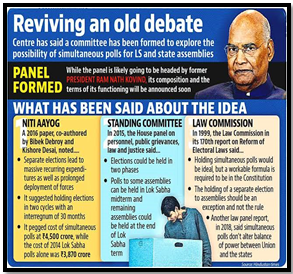COMMITTEE DISCUSSIONS ON ONE NATION, ONE ELECTION
Why in the News?
- Former President Ram Nath Kovind leads the high-level committee on One Nation, One Election.
- Discussion revolves around potential impacts of synchronized elections on GDP growth, fiscal deficits, crime rates, and education outcomes.
Source : HT
Key Points of Discussion:
- Committee evaluated a draft research paper by NK Singh and Prachi Mishra, covering education, GDP growth, and investment impacts of simultaneous elections.
- Participants included Ghulam Nabi Azad and Sanjay Kothari; Amit Shah and Arjun Ram Meghwal were absent.
- Consequences discussed: development disruption, crime impact, security force deployment.
| About “One Nation, One Election”
· Definition and Purpose: o ONOE advocates simultaneous national and sub-national elections. o Aims to streamline the electoral process, cut costs, and potentially boost voter turnout. · Historical Context: Simultaneous elections were initially practiced post-independence, conducting Lok Sabha and state assembly elections together in 1952, 1957, 1962, and 1967. · Discontinuation: Discontinued after 1967 due to early dissolution of some State Legislative Assemblies in 1968-69. · Panel : Panel led by Ex. President Ram nath Kovid is discussing the One Nation, One Election. |

 Source : HT
Source : HT

